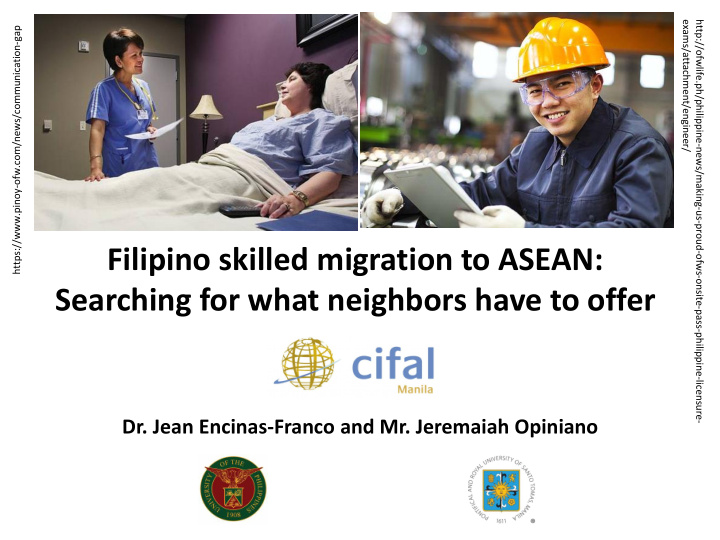



exams/attachment/engineer/ http://ofwlife.ph/philippine-news/making-us-proud-ofws-onsite-pass-philippine-licensure- https://www.pinoy-ofw.com/news/communication-gap Filipino skilled migration to ASEAN: Searching for what neighbors have to offer Dr. Jean Encinas-Franco and Mr. Jeremaiah Opiniano
Contexts • ASEAN integration • Labor mobility and skills recognition • The Philippines as a major source country of international migrants worldwide, across skills
• Benefits and potentials of Filipino skilled migration to Asean. • Who are the Filipino workers in Asean? • Asean countries’ economic competitiveness vis -à-vis labor mobility. • Receptiveness to skilled foreign labor. The paper
1. Skilled Filipino labor in Asean • Not many Filipino workers go to Asean countries
2. Filipino migrants to Asean • Because there are other destina- tions Filipino workers can go to
3. Intra-Asean migration • Within Asean , ‘internal’ Southeast Asian migration flows are topped by those moving within landlocked states
4. ASEAN skilled labor mobility http://aseanup.com/overview-of-the-asean-skilled-labor-market/
4. ASEAN skilled labor mobility 2008 2005 2009 2008 2006 2005 2012 2007 http://aseanup.com/overview-of-the-asean-skilled-labor-market/
• ONLY 1.5 percent of the total ASEAN workforce http://aseanup.com/overview-of-the-asean-skilled-labor-market/
4. ASEAN skilled labor mobility Three challenges for intra-Asean skilled migration to prosper (Asian Development Bank, 2015) • The complexity of countries’ qualifications recognition processes; • National-level barriers within Asean countries for foreign workers in relation to skilled worker quotas and visas; and • Limited interest due to perceived cultural, language and socio-economic differences.
BusinessWorld infographics
5. Asean economic competitiveness
6. Asean countries’ receptiveness? • 2,469,173 international migrants • Categories of foreigners; expatriates [ pegawai dagang ] , foreign skilled workers [ pekerja asing ] , unskilled and semi-skilled workers, foreign students, foreigners under the Malaysia My Second Home program (Kanapathy, 2008) • 3.4 million skilled workers overall (a fourth of country’s workforce). But Malaysia has a skills shortage! (lifted ban on hiring foreign workers in manufacturing, construction, furniture making and plantation sectors [The Daily Samakal, 2016]) • Targets (Eleventh Malaysia Plan, 2015): 5.3 million skilled workers, or 35 percent of total employed workforce
6. Asean countries’ receptiveness? • International labor migration to be handled by a single authority under the Ministry of Human Resources • Malaysia’s qualifications framework, suiting it to Asean’s : TechVoc has eight levels to jive with levels of university-schooled workers. • MAS’ critical occupations list (COL): electrical and electronics, oil and gas, information and communication technology and global business services, telecommunications and multimedia, and financial services and accounting
TalentCorp’s Malaysia My Second Home program - Targets Malaysian citizens abroad and expatriate talents
2011-15: 3,900 RP-T applications OKd. BUT ONLY 6.71 percent come from Asean countries
7. Asean countries’ receptiveness? • 3.44 million employed workers, of which 2.103 million are locals and some 1.404 million foreigners By occupational group, covering all workers by nationality, Singapore has 290.7 thousand professionals and 483.4 thousand associate professionals as of 2014 (Department of Statistics Singapore, 2015)
9. Asean countries’ receptiveness? - Permanent residents: about 527,000 (June 2015) - 8,868 only are non-citizen spouses married to Singaporeans
9. Asean countries’ receptiveness? • Previously, Singapore liberalized its immigration policies so that skilled immigrants gain permanent residency. Singapore even implemented previously programs to ease the costs of hiring skilled workers, and to employ foreigners who graduated from Singaporean skills. • But “liberalization” had received resistance from the Singaporean public giving rising number of foreigners and the impact of the 2008 global financial crisis on Singapore. So some new rules were made.
10. Conclusions • Asean countries as stepping stones for Filipino skilled workers to go outside of Asean • How host countries treat and welcome foreigners and foreign workers matters (not just through immigration policies but through workplace arrangements)
10. Conclusions • ADB’s four components (2015) of a prosperous intra -Asean skilled labor mobility--portable qualifications, increased access to the skilled labor market, adequate supply of skilled professionals and strong demand for skilled professionals — can have a fifth component: international migration policies and their implementation . These migration policies impact on the four earlier components. • Intra-ASEAN skilled migration becomes a government commitment in the spirit of regional solidarity. But workers’ movements outside of ASEAN, or from ASEAN to outside of ASEAN, are their individual decisions. • Take-away question: How is Thailand open to foreign skilled labor, in particular, and foreign labor, in general?
THANK YOU VERY MUCH! • Dr. Jean Encinas-Franco (Assistant Professor, Department of Political Science) jeanfranco825@yahoo.com • Mr. Jeremaiah Opiniano (Assistant Professor and Coordinator [Journalism], Department of Communication and Media Studies; Executive Director, Institute for Migration and Development Issues) ofw_philanthropy@yahoo.com
Recommend
More recommend